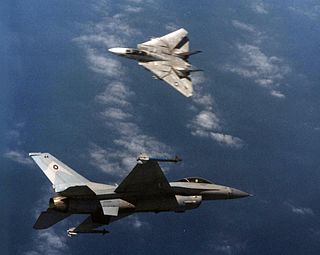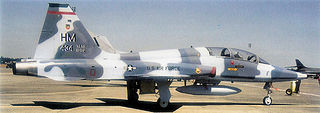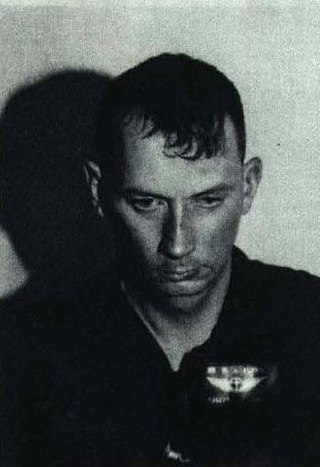
The Mikoyan-Gurevich MiG-19 is a Soviet second generation, single-seat, twinjet fighter aircraft, the world's first mass-produced supersonic aircraft. It was the first Soviet production aircraft capable of supersonic speeds in level flight. A comparable U.S. "Century Series" fighter was the North American F-100 Super Sabre, although the MiG-19 primarily fought against the more modern McDonnell Douglas F-4 Phantom II and Republic F-105 Thunderchief over North Vietnam. This aircraft was originally used by the Soviet Union but it was later used by the People's Liberation Army Air Force.

The Mikoyan-Gurevich MiG-21 is a supersonic jet fighter and interceptor aircraft, designed by the Mikoyan-Gurevich Design Bureau in the Soviet Union. Its nicknames include: "balalaika", because its planform resembles the stringed musical instrument of the same name; "Ołówek", Polish for "pencil", due to the shape of its fuselage, and "Én Bạc", meaning "silver swallow", in Vietnamese.

The Mikoyan-Gurevich MiG-17 is a high-subsonic fighter aircraft produced in the Soviet Union from 1952 and was operated by air forces internationally. The MiG-17 was license-built in China as the Shenyang J-5 and Poland as the PZL-Mielec Lim-6. The MiG-17 is still being used by the North Korean air force in the present day and has seen combat in the Middle East and Asia.

The Lockheed F-104 Starfighter is an American single-engine, supersonic air superiority fighter which was extensively deployed as a fighter-bomber during the Cold War. Created as a day fighter by Lockheed as one of the "Century Series" of fighter aircraft for the United States Air Force (USAF), it was developed into an all-weather multirole aircraft in the early 1960s and produced by several other nations, seeing widespread service outside the United States.

The Douglas A-1 Skyraider is an American single-seat attack aircraft in service from 1946 to the early 1980s, which served during the Korean War and Vietnam War. The Skyraider had an unusually long career, remaining in front-line service well into the Jet Age ; thus becoming known by some as an "anachronism". The aircraft was nicknamed "Spad", after the French World War I fighter.

Operation Rolling Thunder was a gradual and sustained aerial bombardment campaign conducted by the United States (U.S.) 2nd Air Division, U.S. Navy, and Republic of Vietnam Air Force (RVNAF) against the Democratic Republic of Vietnam from 2 March 1965 until 2 November 1968, during the Vietnam War.

A dogfight, or dog fight, is an aerial battle between fighter aircraft conducted at close range. Modern terminology for air-to-air combat is air combat manoeuvring (ACM), which refers to tactical situations requiring the use of individual basic fighter maneuvers (BFM) to attack or evade one or more opponents. This differs from aerial warfare, which deals with the strategy involved in planning and executing various missions.

A flying ace, fighter ace or air ace is a military aviator credited with shooting down five or more enemy aircraft during aerial combat. The exact number of aerial victories required to officially qualify as an ace is varied, but is usually considered to be five or more.
This is a list of aviation-related events from 1965.

Operation Linebacker was the codename of a U.S. Seventh Air Force and U.S. Navy Task Force 77 air interdiction campaign conducted against North Vietnam from 9 May to 23 October 1972, during the Vietnam War.

James "Jabby" Jabara was the first American and United States Air Force jet ace. Born in Oklahoma, he lived in Kansas where he enlisted as an aviation cadet at Fort Riley after graduating from high school. Jabara attended four flying schools in Texas before he received his pilot's wings and was commissioned as a second lieutenant. Jabara flew two tours of combat duty in Europe during World War II as a North American P-51 Mustang pilot, and scored 1.5 air victories against German aircraft.
Nguyễn Văn Cốc is a former North Vietnamese MiG-21 fighter ace of the Vietnamese People's Air Force's 921st Fighter Regiment.

Takhli Royal Thai Air Force Base is a Royal Thai Air Force (RTAF) facility in central Thailand, approximately 144 miles (240 km) northwest of Bangkok in Takhli District, Nakhon Sawan Province.
The Thanh Hóa Bridge, spanning the Song Ma river, is situated 3 miles (4.8 km) northeast of Thanh Hóa, the capital of Thanh Hóa Province in Vietnam. The Vietnamese gave it the nickname Hàm Rồng. In 1965 during the Vietnam War, it was the objective of many attacks by US Air Force and US Navy aircraft which would fail to destroy the bridge until 1972, even after hundreds of attacks. The bridge was restored in 1973. As of 2016, the bridge still stands.

The 479th Tactical Training Wing is an inactive United States Air Force unit. Its last assignment was with Tactical Training, Holloman, stationed at Holloman Air Force Base, New Mexico. It was inactivated on 26 July 1991.

The Vietnam People's Air Force, formally refers itself as the Air Defence - Air Force or the Vietnamese Air Force, is the aerial warfare service branch of Vietnam. It is the successor of the former North Vietnamese Air Force and absorbed the South Vietnamese Air Force following the reunification of Vietnam in 1975 and is one of three main branches of the People's Army of Vietnam, which is under the control of the Ministry of National Defence. The main mission of the VPAF is the defence of Vietnamese airspace and the provision of air cover for operations of the People's Army of Vietnam.
The action of 23 August 1967 was a major air battle which involved elements of the Vietnam People's Air Force (VPAF) and the United States Air Force (USAF). The air battle took place over the skies of North Vietnam as part of Operation Rolling Thunder, during the Vietnam War.

Lieutenant General Winton Whittier Marshall was a United States Air Force general and flying ace. He was deputy commander in chief, U.S. Readiness Command, with headquarters at MacDill Air Force Base in Florida before retiring in 1977.

The 436th Tactical Fighter Training Squadron is an inactive United States Air Force unit. Its last was assigned to the 479th Fighter Group, stationed at Holloman AFB, New Mexico. It was inactivated on 2 August 1991.

Robert James Flynn was a Commander and Naval Flight Officer bombardier/navigator in the United States Navy. As a Lieutenant, he was captured by the Chinese in August 1967 after the A-6 Intruder he was flying in on a mission over North Vietnam was shot down. Flynn and his pilot, along with another A-6 Intruder crew, were evading North Vietnamese jets following their mission over Hanoi when they strayed over the border into Chinese air space. Downed just over the Chinese border, Flynn was apprehended by the Chinese and held in China as a Prisoner of War where he was tortured and held almost exclusively in solitary confinement for five and a half years.

















